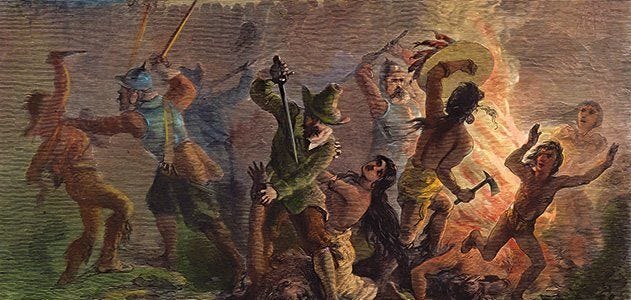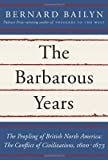Genocidal Pilgrims and Shocking Savagery of Europeans in America’s Formative years

Bernard Bailyn, over 90, is probably one of greatest American historian of the early days of this nation alive today. He has come out with a new book – The Barbarous Years: The Peopling of British North America: The Conflict of Civilizations, 1600-1675
– where he talks about those years when the Native Americans (or “Americans” as he calls them) and the Europeans clashed in genocide of unimaginable proportions.
Those years which are glorified in the Thanksgiving holiday are some of the most treacherous in the history of humanity. The “peaceful pumpkin pie-eating Pilgrims” turned around on the Natives and massacred the Pequots and destroyed their fort near Stonington, Connecticut, in 1637. Thus started the destruction of an entire continent…. and its spiritual underpinning. A people whose life revolved around their spiritual paradigm, which centered on balance and synchronization with the nature.
“Their world was multitudinous, densely populated by active, sentient and sensitive spirits, spirits with consciences, memories and purposes, that surround them, instructed them, impinged on their lives at every turn. No less real for being invisible…the whole of life was a spiritual enterprise…the universe in all its movements and animations and nature was suffused with spiritual potency.”
What surprised me while reading the book review is that these massacres of the Pequots was NOT about land grabbing or colonial conquest, but a religious war.
The Antichrist. The haunting figure presaging the Apocalypse from the Book of Revelation plays an important part in Bailyn’s explanation of the European settlers’ descent into unrestrained savagery. The key passage on this question comes late in his new book when Bailyn makes explicit a connection I had not seen before: between the physical savagery the radical dissenting Protestant settlers of America wreaked on the original inhabitants, and the intellectual savagery of their polemical attacks on the church and state authorities they fled from in Europe—and the savagery of vicious insult and vile denunciation they wreaked upon each other as well.
“The savagery of the [theological] struggle, the bitterness of the main contenders and the deep stain it left on the region’s collective memory” were driven by “elemental fears peculiar to what was experienced as a barbarous environment—fears of what could happen to civilized people in an unimaginable wilderness…in which God’s children [as they thought of themselves] were fated to struggle with pitiless agents of Satan, pagan Antichrists swarming in the world around them. The two [kinds of struggle, physical and metaphysical] were one: threats from within [to the soul] merged with threats from without to form a heated atmosphere of apocalyptic danger.”
And the barbarity of these European invaders was just mind-boggling. It is as if in their quest to hoist Christ over the “pagan” Satans, they were the most extreme incarnation of the worst Satan that nature could conjure up!
Little wonder he calls it The Barbarous Years and spares us no details of the terror, desperation, degradation and widespread torture—do you really know what being “flayed alive” means? (The skin is torn from the face and head and the prisoner is disemboweled while still alive.) And yet somehow amid the merciless massacres were elements that gave birth to the rudiments of civilization—or in Bailyn’s evocative phrase, the fragile “integument of civility”—that would evolve 100 years later into a virtual Renaissance culture, a bustling string of self-governing, self-sufficient, defiantly expansionist colonies alive with an increasingly sophisticated and literate political and intellectual culture that would coalesce into the rationale for the birth of American independence.
Worst is that in response to the unimaginable atrocities of the Europeans, the Natives were far more “human”. They were fighting, but they were doing so because they had no other recourse. But they weren’t into savagery, ironically and irrespective of what the invaders claimed!
“Well, the Indians were not genocidal on the whole. Their effort, even the 1622 massacre [which he calls “genocidal” in his book], was not to wipe the Europeans off the face of the map. It’s the English after the massacre who write these letters saying ‘wipe them off the map.’
It is indeed an interesting shift of consciousness – at least political consciousness that America has come to a point that it has in the last 300 years. If one looks at the massacres of the Natives, the crimes and discrimination against the Blacks, and other such things in a spectrum, the ordeal of African Americans is but a continuation of the nightmare that the Natives of this land suffered. To get from that kind of skewed mind-numbing inhumanity to where the population is today, the shift is nothing short of a miracle!
Featured image: The ”peaceful” Pilgrims massacred the Pequots and destroyed their fort near Stonington, Connecticut, in 1637. A 19th-century wood engraving (above) depicts the slaughter. (The Granger Collection, NYC)






